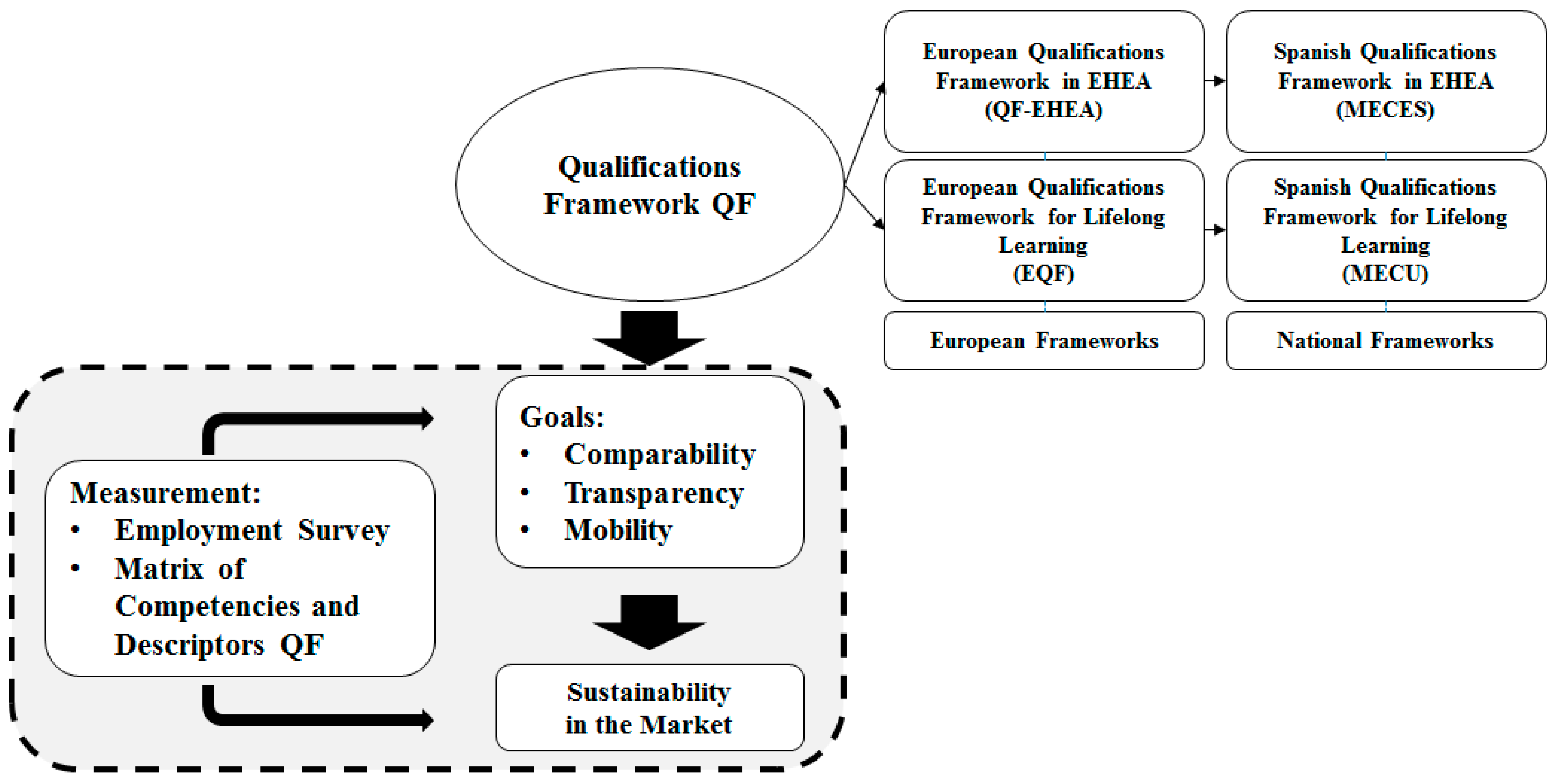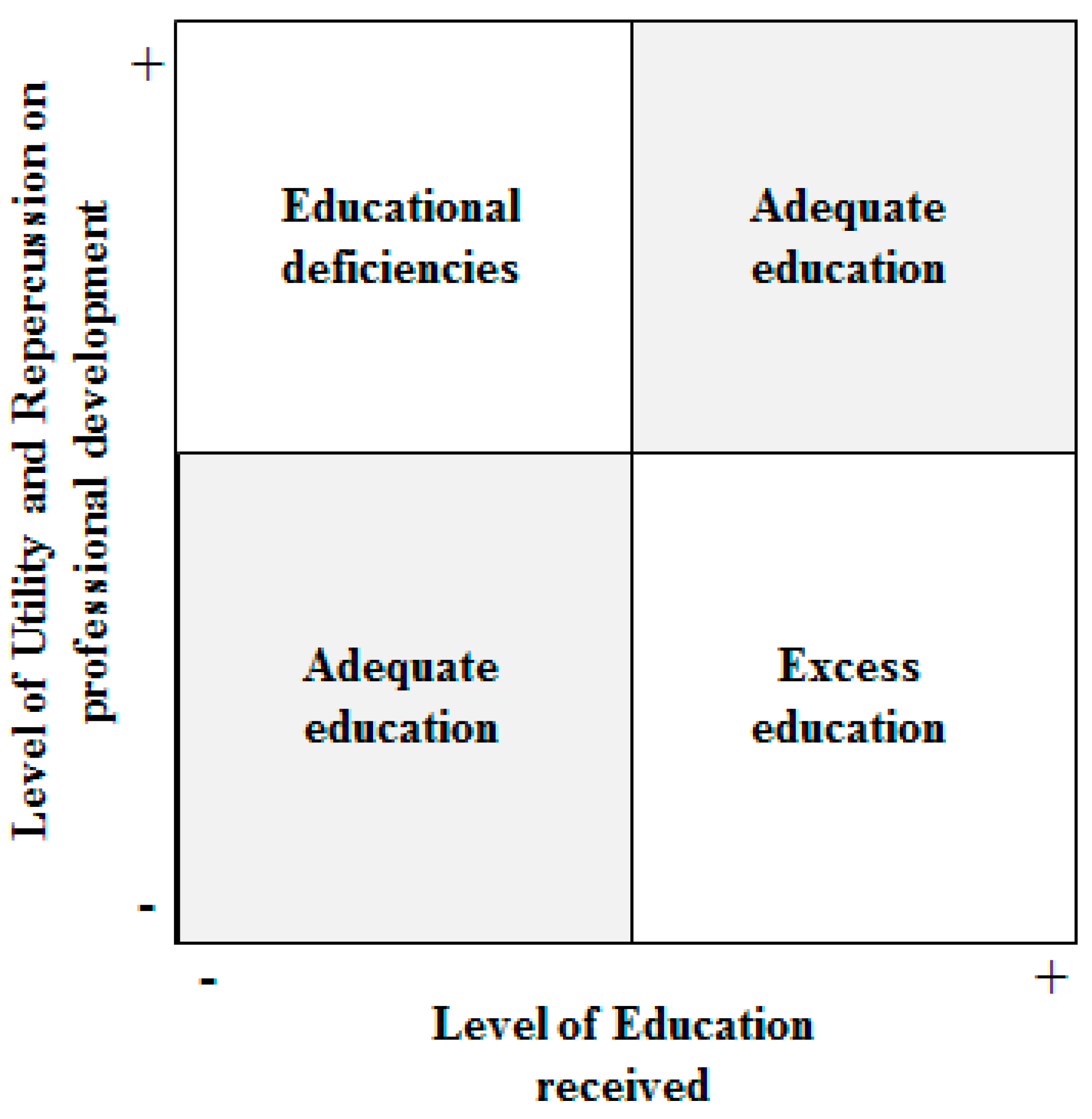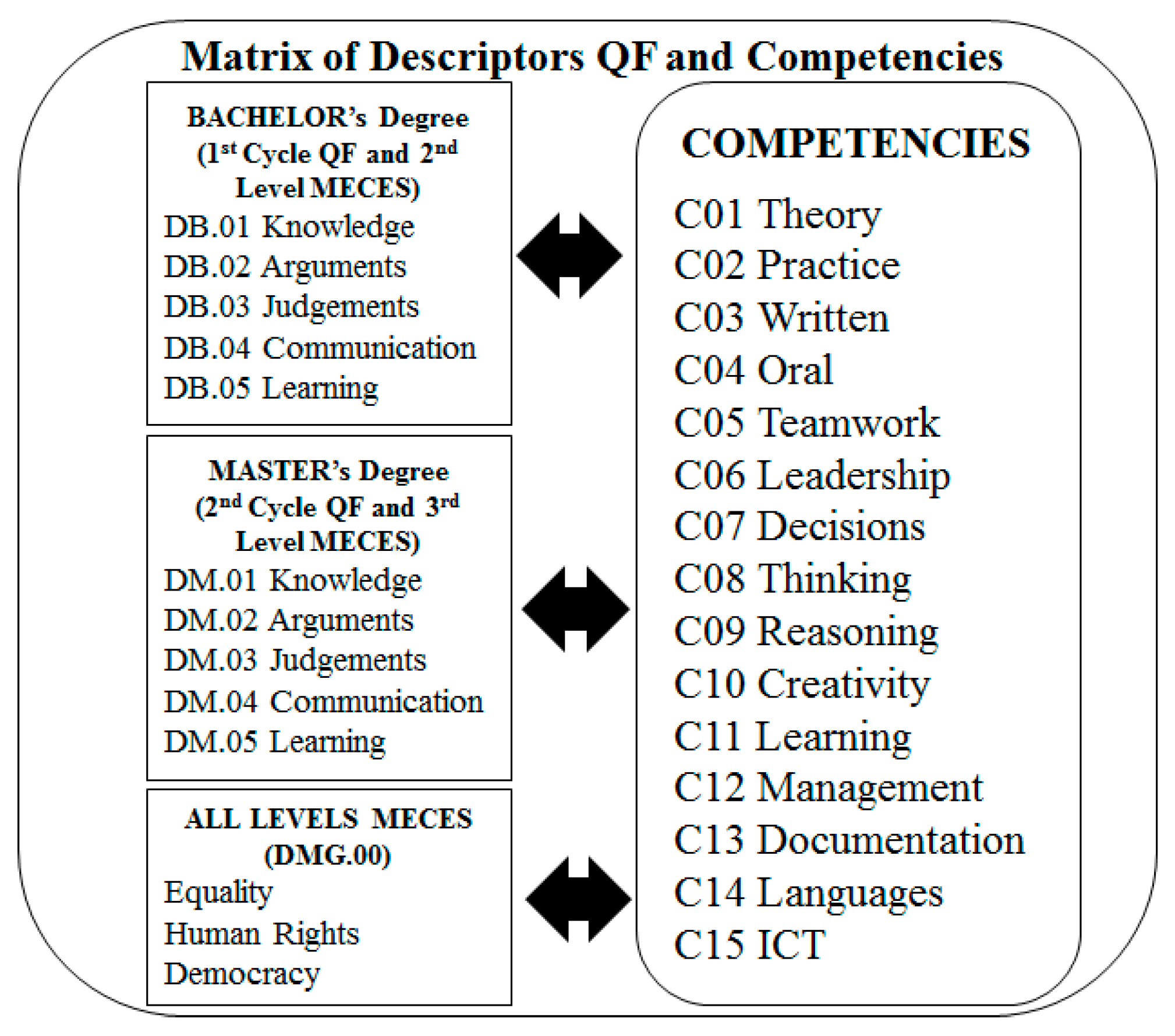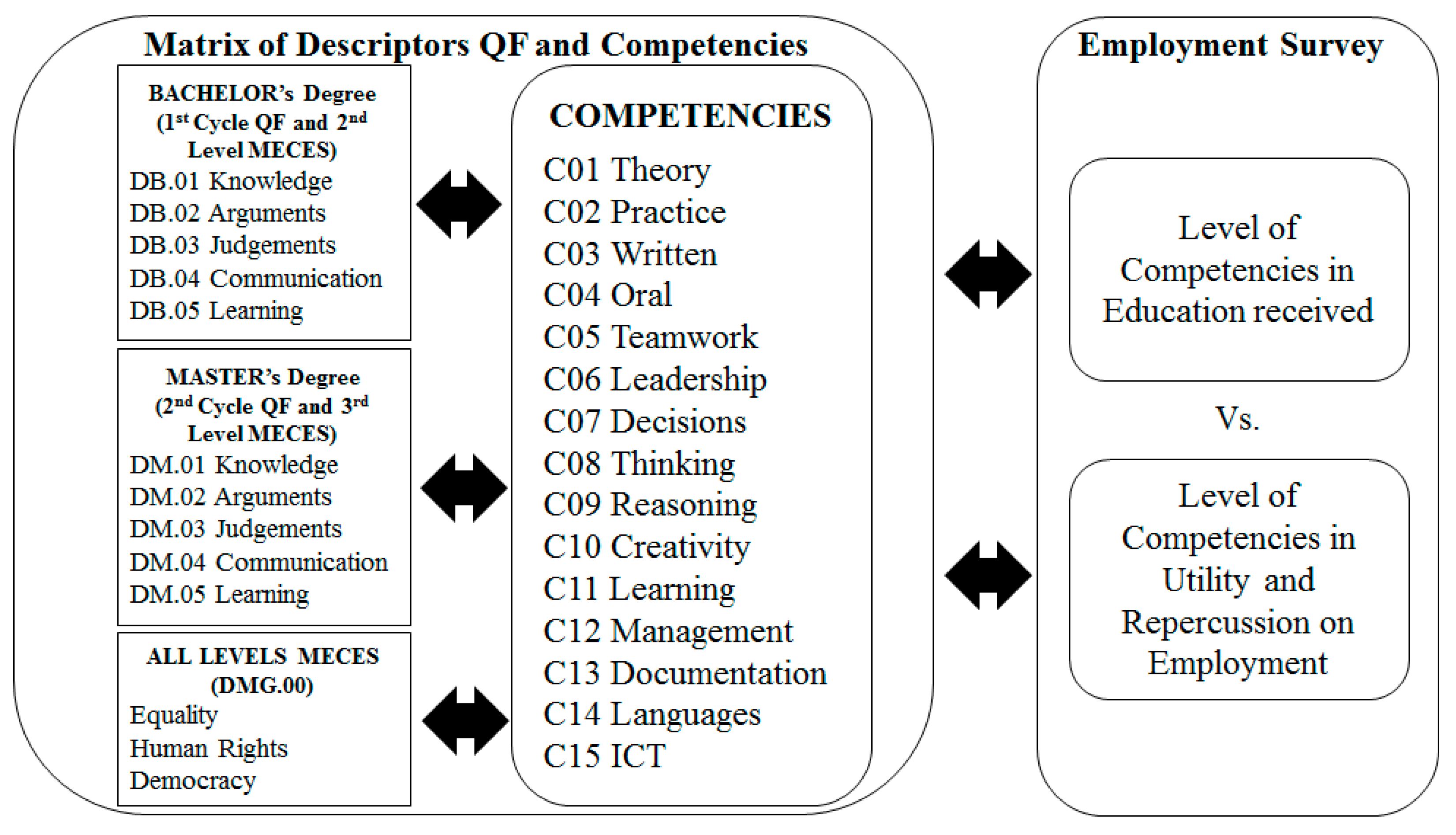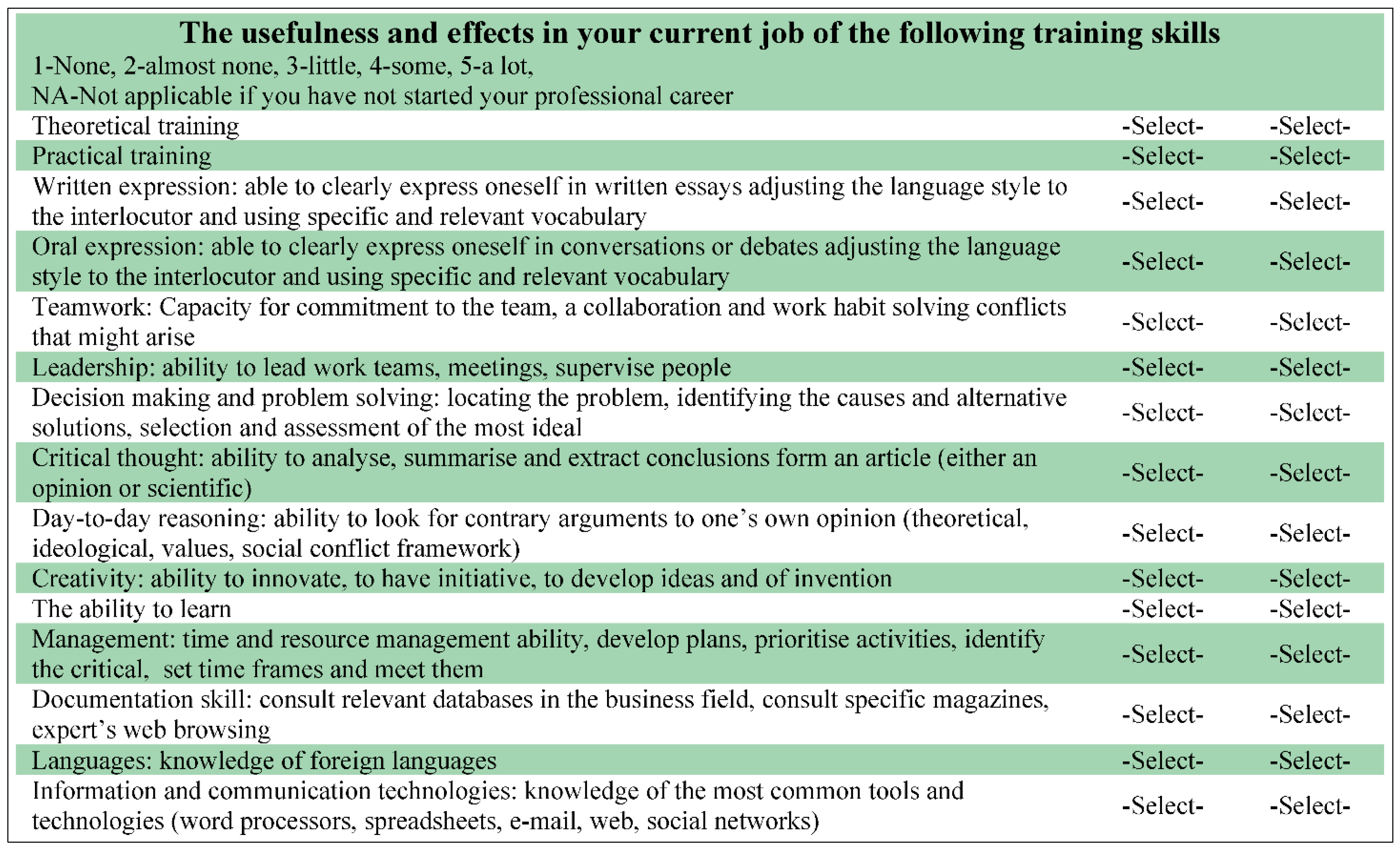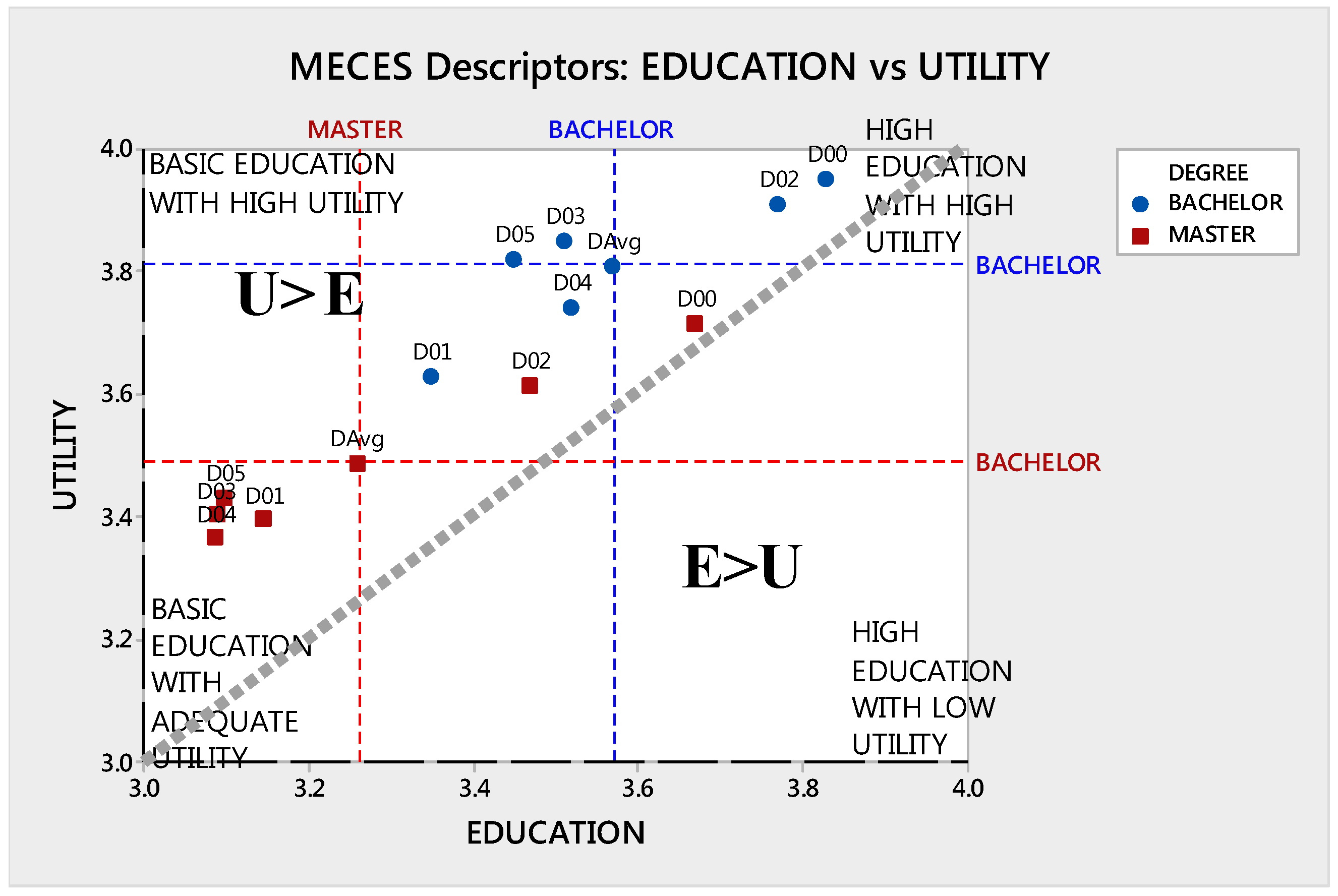Our key innovation is the development of a Survey on Access to the Labor Market (SALM) that quantitatively relates employability and European Framework descriptors, not simply competencies, through differences between levels of education and utility, as perceived by alumni already in the labor market, with at least three years of work experience.
Let us discuss first how employability and competencies are currently being measured and then develop the quantitative SALM to assess the level at which the QF descriptors are deployed into the labor market.
3.1. Quantification of Employability
One of the main concerns raised during the transition to the new European Higher Education Area was to quantify how many graduates attained employment related to their studies and, conversely, how many were in positions which did not correspond to the level of their studies. The difficulty in measuring the data to analyze possible mismatches between employment and studies led to considerable research into European countries. Most studies focused on identifying levels of education versus utility and their repercussion on employment.
In this context, a highly valuable source of data for these studies was the CHEERS project (Careers after Higher Education: a European Research Study). This project, supported by the EU’s TSR [
15] program, was launched in 1997 by a group of European and Japanese researchers, and its objective was to analyze the employment and jobs of graduates from higher education institutions in nine European countries—in addition to Japan—during the first years after graduation. The CHEERS Project developed a questionnaire for these graduates and collected responses from 3000 individuals, providing information on the relationship between higher education and employment four years after graduation. The questionnaire listed competency groups—36 different items relating to the competencies provided and required—which had to be evaluated from the perspective of education, as well as their utility and repercussion on employment, among other study variables. Four years later, the program had collected a database with information from over 40,000 surveys.
The repercussions of the CHEERS Project led not only to numerous publications and articles about the Project itself but also to a trend in analyzing “Access to the labor market” from that moment onwards in all EHEA member states. In this regard it is worth noting that comparability in the EHEA is only possible by gathering information from all European studies about the processes of graduate employability. Many of these studies agree in highlighting the inherent difficulty in comparing between countries, due to diverging policies in many cases, as well as differences between the statistical methodologies applied [
14] and the indicators used for measuring and interpreting the study variables. Nevertheless, they also agree in highlighting the importance of these studies on graduates, in terms of relevant indicators in the analysis of the relationship between “higher education and employment”.
Researchers who, since then, have studied competencies and employability in Europe—and also outside—have also provided some needs and elements to reflect upon, which could be grouped into different categories including socioeconomic aspects, educational–employment policies, and characteristics of the relationship between the stakeholders involved—educational institutions, graduates and employers:
(a) Some ascribe more importance to socioeconomic factors than to aspects of competition [
49] as the source of the problem of unemployment. Thus, we find some authors who underscore the unforeseeable consequences of a constant increase in the percentage of the population with higher education [
50]. Meanwhile, others highlight the importance of structural factors, such as heterogeneity within the labor markets in each country [
51]—socioeconomic imbalances between the north and south [
14], or the types of educational programs and fields of study, as well as personal factors; gender and economic standing of a graduate’s family [
52]; level of parental education, competencies at the time of graduation, employment conditions—economic sector, size of the organization, and the experience after graduation [
53]. Other opinions in this regard, which serve to balance the debate, point out that going through university tends to iron out class differences soon after graduation, thus arguing that any initial social differences do not represent a discriminating factor in terms of employability [
54].
(b) Another set of aspects highlighted by researchers are related to educational and labour policies. These include a need for greater balance and alignment between educational policies and employment policies, to foster an improvement in employability within countries [
31]. In this regard, some have suggested a need to prioritize the Bologna Declaration
versus the objectives of national higher education policies [
34]. Some authors describe certain irregular situations detected, such as salary mismatches stemming from the replacement of non-graduate technical staff with graduates [
55]; others even consider analyzing the importance of having a degree or not, in terms of employability [
56]. Many consider it necessary for higher education to become aware of and adapt to the requirements of the labor market, thus preparing students to play a more proactive role in society [
57]. Such proposals suggest increasing the flexibility of higher education programs, in order to facilitate a rapid response in terms of optimizing the quantity and quality of those competencies [
58] truly demanded by the labor market, as well as reducing the focus on competencies already offered by an excessive number of graduates [
35,
59]. In this area some point to the “over-education” phenomenon which is mainly seen in Spain [
60]. Another point highlighted is the need to focus on curricular design of aspects such as: emphasis on general knowledge and flexibility; problem-solving capacity; contrast between theory and practice; multidisciplinarity; international competencies,
etc. [
57] In turn, other studies [
46] conclude that labor markets seem to mainly value the capacity of graduates in higher education to combine their studies with employment; that is, a capacity to manage heavy workloads, combined with intellectual flexibility. In this regard, European universities must develop students’ competencies and prepare them for sustainable employment by fostering reforms initiated within the framework of the Bologna process [
61].
Employment policies should address the need to apply micro- and macroeconomic policies [
62], seeking new, unconventional ideas and policies in order to help create the necessary volume of high-quality employment to meet current adverse conditions [
63]. Furthermore, it is also important to consider the need to modify and strengthen employment protection regulations to favor worker mobility within Member States and avoid an exodus of graduates who are attracted by better conditions offered in certain countries [
36]. Nevertheless, many studies conducted with a more global approach support the belief that HEI may have a legal framework which favors undergraduate and postgraduate/master’s training programs which are tailored to the demands of worldwide labour markets. Therefore, it is important to analyze not only the need for local policies enabling HEI to offer flexible programs adapted to the changing needs of labor markets, but also including in those programs the competencies demanded beyond the home continent of each institution. These programs must address a globalized labor market by fostering competencies based on transcontinental requirements.
(c) The studies also highlight a need for a more effective interaction between educational institutions, graduates and employers [
64]. This need for the participation of those involved in the process of the new EHEA was one of the points highlighted by the 2001 Prague Communique [
65], although it only refers to universities and graduates. Several authors also involve other agents; for example, teaching staff, who should be trained to manage the new needs of an education system based on the competencies and knowledge demanded by the labor market at any time [
66]. On the other hand, some experts point to the decisive role of employers in the initial professional training of graduates and their subsequent continuous development [
47], detecting their needs and difficulties—for example, in terms of communication competencies [
67]. Others go beyond competencies and highlight the importance of graduates’ own experience in a position where employers actively participate in a structured design of their training to favor employability [
68]. In relation to the evaluation of all parties involved, one line of research followed by academics from several higher education institutions includes running employability studies through surveys aimed at different groups [
69,
70] with the aim of favoring a better match between university graduates and real job offers.
All the lines of research analyzed for the present study promote a need to measure and analyze the education received within the EHEA, in view of the requirements of employers in a global labor environment through quantification of the competencies and descriptors in the European frameworks.
3.2. Identification of Competencies
The definition of the descriptor for the European Qualifications Framework is based on the fact that “
They are of necessity quite general in nature” [
7,
71] so as to be applicable to a whole range of disciplines existing in the EEAs.
However, after the publication of the Bologna Framework 2005, debates arose regarding the generalist competence implied by the descriptors described in the European Qualifications Framework. Research was conducted to this effect, such as that by Wirtenton in 2009 [
32,
41,
72] where the Competence models and the European Qualifications Framework are analyzed and the debate on the existence of a great diversity of competence models is exposed, not only existing within, but also between EEA countries; so, too, the need for the existence of a sufficiently large common ground for a common European focus to support the European Qualifications Framework.
Despite the debate of posterior research studies on the generalist focal points of competences described for the QF-EHEA descriptors, this research proposes a competence identification analysis in line with the QF descriptors and supports the same generalist aim with which the Descriptors were proposed by the Bologna Framework [
7].
The analysis and identification of competencies to measure the different qualifications frameworks were based on several of the studies cited throughout the project, particularly the literature on general competencies.
In this regard,
Table 2 includes a thorough comparison of the state of the art in terms of the competencies that have been used in the past. The studies analyzed were the most relevant in the field of competencies and employability of graduates, from the influential CHEERS Project conducted in 2000 up to the present.
Table 2 was produced in the following phases:
- (1)
Identification of the major articles, included in the first row.
- (2)
Identification of the competencies used in each research project, included in the first column.
- (3)
Identification of the competencies with the initials of the author/s and numbering from 1 to the total number of competencies examined in each study. The last row identifies the total number of competencies used in each of the articles analyzed.
- (4)
Assignment of each competency used in each article with one or more of the 36 competencies used in the CHEERS Project, and which served as a basis for all future research work, except for 4 competencies, for which there is direct association with the competencies of the CHEERS Project.
- (5)
Identification of a number of competencies summarizing the overall set of competencies used by the studies analysed, reducing the 40 competencies to a more manageable figure of 15. We include a comparison between CHEERS and the study by García-Aracil in
Appendix as an example.
The selection of the “best 15” is not only because they are the ones that are most repeated but also because they are the ones that are best aligned with the competencies described by the Descriptors in the European QF-EHEA and MECES Qualifications Framework. The result of this phase is shown in the last column of the table, with a total of 15 competencies, coded with the initials of the authors and aligned to one or more of the 40 competencies listed in the first column.
The final list of competencies proposed in this article is as follows:
C01. Theoretical education.
C02. Practical education.
C03. Written expression: knowing how to express ideas clearly when drafting texts, adapting the language style to the target audience, and using specific and relevant vocabulary.
C04. Oral expression: knowing how to express ideas clearly in conversations or debates, adapting the language style to the intended audience, and using specific and relevant vocabulary.
C05. Teamwork: ability to reach a compromise within a team, habit of collaborating, and working together to resolve any conflicts that may arise.
C06. Leadership: capacity to lead working groups and meetings, and to supervise others.
C07. Decision-making and problem solving: identification of problems, causes, and different alternatives; selection and evaluation of the most appropriate ones.
C08. Critical thinking: capacity to analyze, summarize, and draw conclusions from an article—be it an opinion or scientific article.
C09. Everyday reasoning: capacity to find arguments defending the opposite opinion to one’s own—theoretical framework, ideology, values, social conflicts, etc.
C10. Creativity: capacity for innovation, initiative, promoting ideas and inventiveness.
C11. Learning ability.
C12. Self-management: capacity to manage schedules and resources: develop plans, prioritize activities, identify criticism, set targets, and meet them.
C13. Documentation: consulting relevant databases in each professional field; specific publications, “expert” Internet browsing.
C14. Languages: knowledge of foreign languages.
C15. Information and communication technologies: knowledge of the most common tools and technologies: word processors, spreadsheets, e-mail, web browsing, social networks, etc.
Table 2.
Competencies analyzed in studies of employability of higher education graduates in research works between 2010–2015.
Table 2.
Competencies analyzed in studies of employability of higher education graduates in research works between 2010–2015.
| | Competencies | Teichler, U. [57] | Vidal, J.; López, R.; Pérez, C. [73] | Gallardo Vigil, M.A. [74] | Matlay, H.; Rae, D. [75] | Vaatstra, R.; de Vries, R. [76] | García-Aracil, A.; van der Velden, R. [17] | Andrews, J.; Higson, H. [77] | Jurse, M.; Tominc, P. [18] | De Guzmán, A.B.; de Castro, B.V. [78] | Salisbury, M.H.; Umbach, P.D.; Paulsen, M.B.; Pascarella, E.T. [79] | Ionescu, I.; Guillaume, J.-F.; Pelt, V.; Baumann, M.; Amara, M.-E. [61] | Ruiz Carrascosa, J. [80] | Azevedo, A.; Apfelthaler, G.; Hurst, D. [81] | Bachynsky, E.A.; Dale, V.H.M.; Kinnison, T.; Gazzard, J.;Baillie, S. [67] | Deaconu, A.; Osoian, C.; Zaharie, M.; Achim, S.A. [38] | Cebrián, G.; Junyent, M. [20] | Serrano, G.; Llamazares, F.; Otamendi, F.J. |
|---|
| 1 | Broad general knowledge | CH.01 | VLP.07 | | | | GAV.29 | JH.01 | | GC.03 | | | RC.04 | | | | | |
| 2 | Cross-disciplinary thinking/knowledge | CH.02 | | | | VV.01 | GAV.22 | | | GC.03 | | | RC.04 | AAH.06 | | DOA.21 | CJ.06 | |
| 3 | Field-specific theoretical knowledge | CH.03 | VLP.07 | GV.01 | | VV.02 | GAV.30 | | | GC.03 | | | RC.04 | | | DOA.09 | | C.01 |
| 4 | Field-specific knowledge of methods | CH.04 | VLP.07 | GV.02 | | VV.03 | GAV.23 | | | GC.01 | | | RC.02 | | | DOA.07 | | C.02 |
| 5 | Foreign language proficiency | CH.05 | VLP.12 | GV.14 | | | GAV.32 | | JT.10 | GC.02 | | | RC.03 | | | DOA.17 | | C.14 |
| 6 | Computer skills | CH.06 | VLP.12 | GV.03 | RAE.15 | | GAV.05 | JH.05, JH.08 | JT.09 | GC.01 | | IGPBA.06 | RC.01 | | | DOA.12 | | C.15 |
| 7 | Understanding complex social, organisational and technical systems | CH.07 | VLP.12 | GV.03 | RAE.15, RAE.19 | | GAV.14 | JH.03, JH.04, JH.08 | JT.14 | GC.01 | SUPP.03 | IGPBA.06 | RC.01 | AAH.06 | BD.13 | DOA.12 | CJ.02 | C.12 |
| 8 | Planning, co-ordinating and organising | CH.08 | VLP.11 | GV.05 | RAE.14 | VV.04 | GAV.02 | JH.10 | JT.13 | GC.01 | | | RC.02 | AAH.04 | | DOA.02 | | C.12 |
| 9 | Applying rules and regulations | CH.09 | | | RAE.19 | | | JH.01 | JT.08 | GC.01 | | | RC.01 | | | | | |
| 10 | Economic reasoning | CH.10 | | | RAE.02, RAE.16 | | GAV.07 | | | GC.03 | | | RC.04 | | BD.01, BD.02, BD.03, BD.07, BD.08, BD.10,BD.14 | | | |
| 11 | Documenting ideas and information | CH.11 | VLP.11 | GV.05 | RAE.03, RAE.14 | | GAV.15 | JH.10 | JT.09, JT.13 | GC.01 | SUPP.03 | | RC.02 | | | | | C.12, C.13 |
| 12 | Problem-solving ability | CH.12 | VLP.05 | GV.06 | RAE.05 | VV.05 | GAV.09 | | JT.05, JT.12 | GC.03 | | IGPBA.03 | RC.04 | | | DOA.06 | | C.07 |
| 13 | Analytical competencies | CH.13 | VLP.07 | GV.12 | RAE.10, RAE.16 | VV.06 | GAV.21 | | JT.14 | GC.03 | | | RC.04 | AAH.03 | | | CJ.04 | |
| 14 | Learning abilities | CH.14 | VLP.09 | | RAE.17 | VV.07 | GAV.31 | | JT.07 | GC.03 | SUPP.08 | | RC.04 | | | DOA.05 | | C.11 |
| 15 | Reflective thinking, assessing one’s own work | CH.15 | VLP.10 | | | VV.08 | GAV.17 | | JT.04 | GC.03 | | | RC.04 | AAH.04 | | DOA.01 | | C.08 |
| 16 | Creativity | CH.16 | VLP.08 | GV.13 | RAE.05 | | | JH.09 | | GC.03 | | | RC.04 | | | | CJ.08 | C.10 |
| 17 | Working under pressure | CH.17 | VLP.11 | GV.05 | RAE.14 | | GAV.06 | JH.10 | JT.13 | GC.03 | | | RC.04 | | BD.04 | DOA.13 | CJ.07 | C.12 |
| 18 | Accuracy, attention to detail | CH.18 | | | | | GAV.16 | | | GC.01 | | | RC.02 | | | | | |
| 19 | Time management | CH.19 | VLP.11 | GV.05 | RAE.01, RAE.14 | | GAV.04 | JH.10 | JT.13 | GC.03 | | | RC.04 | AAH.04 | | DOA.03 | | C.12 |
| 20 | Negotiating | CH.20 | | | RAE.10 | | GAV.01 | JH.06 | | GC.02 | SUPP.06 | | RC.03 | AAH.01 | BD.06, BD.09 | DOA.18 | | |
| 21 | Fitness for work | CH.21 | | | RAE.10 | | | JH.01 | | GC.03 | | | RC.04 | | | DOA.04 | | |
| 22 | Manual skills | CH.22 | | | | | | | | GC.01 | | | RC.01 | | | DOA.07 | | |
| 23 | Working independently | CH.23 | VLP.07 | GV.04 | RAE.01 | VV.09 | GAV.18 | | JT.01 | GC.03 | | | RC.04 | AAH.04 | | DOA.04 | | |
| 24 | Working in a team | CH.24 | VLP.03 | GV.08 | RAE.12 | VV.10 | GAV.13 | JH.06 | JT.15 | GC.02 | SUPP.02, SUPP.04, SUPP.06 | IGPBA.04 | RC.03 | AAH.02 | BD.11, BD.16 | DOA.08 | | C.05 |
| 25 | Initiative | CH.25 | | GV.13 | RAE.03 | | GAV.12 | JH.05 | | GC.03 | SUPP.02 | | RC.04 | | | DOA.11 | | |
| 26 | Adaptability | CH.26 | | | RAE.18 | | GAV.19 | | JT.06 | GC.02 | SUPP.02 | | RC.03 | | BD.04 | DOA.05, DOA.14 | CJ.03 | |
| 27 | Assertiveness, decisiveness, persistence | CH.27 | VLP.11 | GV.05 | RAE.07, RAE.14 | | GAV.11 | JH.10, JH.02 | JT.13 | GC.03 | | | RC.04 | AAH.01 | | | CJ.07 | C.12 |
| 28 | Power of concentration | CH.28 | | | | | GAV.28 | | | GC.03 | | | RC.04 | AAH.04 | | | | |
| 29 | Getting personally involved | CH.29 | | | RAE.01 | | GAV.20 | JH.01 | | GC.03 | SUPP.02 | | RC.04 | | | | CJ.07 | |
| 30 | Loyalty, integrity | CH.30 | VLP.07 | | | | GAV.25 | | | GC.03 | SUPP.02, SUPP.04 | | RC.04 | | | | CJ.01 | |
| 31 | Critical thinking | CH.31 | VLP.06 | GV.13 | | | GAV.27 | | | GC.03 | | IGPBA.02 | RC.04 | AAH.03 | | DOA.20 | CJ.01, CJ.05 | C.08 |
| 32 | Oral communication skills | CH.32 | VLP.02 | GV.10 | RAE.09 | | GAV.10 | JH.07 | | GC.02 | | | RC.03 | AAH.08 | BD.05, BD.09, BD.12,BD.15 | DOA.10 | | C.04 |
| 33 | Written communication skills | CH.33 | VLP.01 | GV.11 | RAE.09 | | GAV.26 | JH.07 | | GC.03 | | IGPBA.01 | RC.04 | AAH.07 | | DOA.16 | | C.03 |
| 34 | Tolerance, appreciating of different points of view | CH.34 | VLP.07 | GV.09 | | | GAV.24 | JH.01, JH.06 | | GC.02 | SUPP.01, SUPP.05 | | RC.03 | AAH.02 | | DOA.15 | | |
| 35 | Leadership | CH.35 | VLP.04 | GV.07 | RAE.08, RAE.11 | | GAV.08 | JH.05 | JT.11 | GC.03 | | IGPBA.05 | RC.04 | AAH.05 | | DOA.19 | CJ.08 | C.06 |
| 36 | Taking responsibilities, decisions | CH.36 | VLP.05 | | RAE.06, RAE.08 | | GAV.03 | JH.05, JH.11 | | GC.03 | | | RC.04 | | | DOA.07 | CJ.03 | C.07 |
| 37 | Participating in social and industry or professional networks. | | | | RAE.13 | | | | | GC.02 | | | RC.03 | | | | | |
| 38 | Ability to work in an international context | | | | | | | | JT.02 | GC.02 | SUPP.01, SUPP.05 | | RC.03 | | | | | |
| 39 | Appreciation of diversity and multiculturality | | | | | | | | JT.03, JT.16 | GC.02 | SUPP.01, SUPP.05, SUPP.07 | | RC.03 | | | | | C.09 |
| 40 | Accountability in completing tasks | | | | | | | | | | | | | | | DOA.01 | | |
| | Total competencies | 36 | 12 | 14 | 19 | 10 | 32 | 10 | 15 | 3 | 8 | 6 | 4 | 8 | 16 | 21 | 8 | 15 |
3.3. From Competencies to Framework Descriptors
Our first key new feature is the identification of the descriptors associated to the levels of Bachelor’s and Master’s degree required by QF-EHEA, and their association with student competencies (
Figure 3). The descriptors of the QF-EHEA qualifications were translated into the Spanish MECES qualifications framework with no modifications, adding to the latter certain generic descriptors that must be achieved at both levels: Bachelor’s and Master’s degree, and which will be taken into account in the measurement made by this research. As previously pointed out in the study, the Spanish MECES qualifications framework is equivalent to the qualifications required by the European QF-EHEA qualifications framework.
Figure 3.
Descriptors and competencies.
Figure 3.
Descriptors and competencies.
Prior to the association of competencies to each of the descriptors, the same nucleus was identified for each of the corresponding descriptors, both at the level of Bachelor’s and Master’s degree: Nevertheless, despite sharing the same nucleus, its scope determined the specifications, which led us to investigate the association between different competencies for each descriptor of for Bachelor and Master’s degree level separately. Furthermore, it is important to point out that the competencies evaluated in this research may not coincide for each descriptor at each course level, given the differences in scope in the descriptors for each level. It is also worth noting the possibility that one single competency may be associated with the measurement of several of the aspects included in a descriptor. However, the descriptors should be considered by any under- or postgraduate, regardless of their field of specialization and the EHEA country where the course takes place.
Table 3 associates the competencies enumerated for the measurement of a qualifications framework for each of the descriptors in the qualification levels of the European QF-EHEA and MECES Qualifications Framework for the level of Bachelor’s and Master’s degree. The cell values specify the part of each descriptor that should be covered partly or fully by one or more of the 15 competencies. The conversion values should be a number between 0 and 1. In this first version of the methodology we have preferred to initialize the values to either 0 (not covered) or 1 (at least partially covered) but the user of the methodology may choose any value within the 0–1 range without losing validity.
Table 3.
List of competencies associated to the descriptors of the European QF-EHEA and MECES Qualifications Framework for the levels of Bachelor’s and Master’s degree.
Table 3.
List of competencies associated to the descriptors of the European QF-EHEA and MECES Qualifications Framework for the levels of Bachelor’s and Master’s degree.
| D | Descriptors | QF-EHEA 1st Cycle ≈ MECES 2nd (BACHELOR)_DB | QF-EHEA 2nd Cycle ≈ MECES 3rd (MASTER)_DM | MECES GENERAL_DMG00 |
|---|
| DB01_1st Descriptor | DB02_2nd Descriptor | DB03_3rd Descriptor | DB04_4th Descriptor | DB05_5th Descriptor | DM01_1st Descriptor | DM02_2nd Descriptor | DM03_3rd Descriptor | DM04_4th Descriptor | DM05_5th Descriptor | MEGE01 | MEGE02 | MEGE03 |
|---|
| C | Competencies |
| C01 | Theoretical education | 1 | | | | | 1 | | | | | | | |
| C02 | Practical education | | 1 | | | | 1 | | | | | | | |
| C03 | Written expression | 1 | | 1 | | | | 1 | | | | | | |
| C04 | Oral expression | | 1 | | 1 | | 1 | | 1 | | | | | |
| C05 | Team work | | | | | | | 1 | | | | 1 | 1 | 1 |
| C06 | Leadership | | 1 | | 1 | | 1 | | 1 | | 1 | | | |
| C07 | Decision making and problem solving | | | 1 | | | | 1 | | | 1 | 1 | 1 | 1 |
| C08 | Critical thinking | | | 1 | | | | 1 | | | | | | |
| C09 | Everyday reasoning | | | | | | | 1 | | | 1 | 1 | 1 | 1 |
| C10 | Creativity | | | | | 1 | | | | 1 | | | | |
| C11 | Learning ability | | | | | 1 | | | | 1 | 1 | | | |
| C12 | Management | | | 1 | | | | 1 | | | | | | |
| C13 | Documentation | | | 1 | | 1 | | 1 | | | | | | |
| C14 | Languages | 1 | | | 1 | | 1 | | 1 | 1 | | | | |
| C15 | Information and communication technologies | 1 | 1 | | | 1 | 1 | | | | 1 | | | |
3.4. The Survey SALM
The measurement method proposed consists of a Survey on Access to the Labor Market (SALM) for EHEA graduates which integrates evaluations of education (LE) and utility and repercussion (LU) of the 15 competencies identified in the previous section to measure the EQF-EHEA/MECES levels with other variables of interest for the analysis of employability and evaluation of study plans (
Figure 4).
Figure 4.
Descriptors vs competencies vs employment survey.
Figure 4.
Descriptors vs competencies vs employment survey.
Each competency is assessed with an individual question which focusses on achievements; since it is considered that the process can be evaluated taking into account the perception of university graduates, three years after completing their studies.
The questionnaire presented the following distribution of question blocks:
Profile of graduates (14 items for Bachelor’s degree graduates and 12 items for Master’s degree graduates)
Professional profile:
- ○
Employed during the course (Master’s graduates) (eight items)
- ○
First job after completing the course (Bachelor’s and Master’s graduates) (eight items)
- ○
Currently employed (after three years of completing the Bachelor’s or Master’s degree) (nine items)
Questions about standards of education and levels of utility (15 items)
“Satisfaction with education received” and “satisfaction with current employment” (six items)
The survey was designed to be run online, with independent questionnaires designed for Bachelor’s and Master’s degrees—in both Spanish and English, based on the language which the course was taught in.
Each of the 15 questions was based on a five-point Likert scale, following the CHEERS methodology. The respondents were asked to click one option to proceed to the next question, so they had to provide 30 values: 15 for the level of education (LE) and 15 more for the level of utility (LU).
Figure 5 shows a screenshot of the 15 questions in English.
Figure 5.
A screenshot of the SALM.
Figure 5.
A screenshot of the SALM.
3.5. Sustainability Indicators
Each participant p in the SALM gives an answer to the 15 competencies c, both for the level of education LEcp and the level of utility LUcp. LE and LU will then be taken from the average over all the participants and competencies for each level independently.
The indicator for measuring sustainability was the adequacy of or concordance between the education and its utility at the workplace. We defined adequacy as “LE-LU”, with positive values indicating that the education level was greater than what was needed at the workplace, whereas negative values indicated good use of the standard of education in the workplace.
The analysis could however be performed for each of the 15 competencies, in order to obtain more information about the actions that should be taken by the stakeholders. Then, for each participant
p, we can calculate the pair difference between LE
cp and LU
cp or (LE-LU)
cp; and for the sample as a whole, the average for each competency (LE-LU)
c:
The indicator for the competencies is straightforward, whereas the one for each of the descriptors of the framework needs fine-tuning. The value for each descriptor is the weighted average of the values of the competencies, where the conversion weighs
wcd are 0 or 1, depending upon the influence of the competence in the descriptor as dictated by
Table 6 (1 corresponds to the relationships identified and depicted by letters, and 0 to the blank cells). Therefore:
where:
As an example, descriptor 1 for the undergraduate degree will include and average out the values for C01 (w11 = 1), C03 (w31 = 1), C14 (w141 = 1) and C15 (w151 = 1). The weight of the rest of the competencies is 0 (wc1 = 0).
For both the competencies and the descriptors it is then necessary to determine whether the difference between education and utility is significantly different from 0. In this regard, we shall perform the traditional hypothesis test based on the paired comparison of individual values for the sample as a whole, for competencies or descriptors.
H0: (LE−LU) = 0 vs H1: (LE−LU) ≠ 0
H0: (LE−LU)c = 0 vs H1: (LE−LU)c ≠ 0
H0: (LE−LU)d = 0 vs H1: (LE−LU)d ≠ 0
In summary, the descriptors and competencies that show a significant difference between LE and LU may be altered by the HEI. We also considered that values of LE or LU over 3 were appropriate, whereas values those under that threshold indicated that the corresponding item needed attention.
